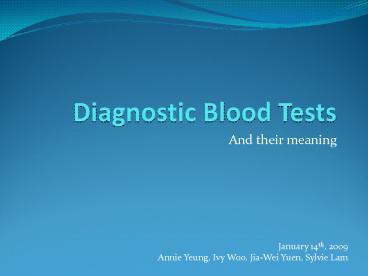Diagnostic Blood Tests - PowerPoint PPT Presentation
1 / 21
Title:
Diagnostic Blood Tests
Description:
dilute urine (false-negative) hematuria / proteinuria (false-positive) ... Diuretics (false-negative) Anticonvulsants, antiparkinsonian drugs (false-positive) ... – PowerPoint PPT presentation
Number of Views:2051
Avg rating:3.0/5.0
Title: Diagnostic Blood Tests
1
Diagnostic Blood Tests
- And their meaning
January 14th, 2009 Annie Yeung, Ivy Woo, Jia-Wei
Yuen, Sylvie Lam
2
Why tests are ordered?
- TWO major reasons why physicians order tests
- For diagnosis of disease or condition
- For management of illness or health
3
Purposes
- Diagnostic Testing
- To confirm a condition that there is some
evidence for - To exclude a disease that is possible but not
likely - To screen for disease without symptoms
- To determine risk factors for disease
4
Purposes
- Management Testing
- To monitor the treatment of a disease
- To follow the course of the disease
- To predict what is likely to happen to the
patient (prognosis)
5
Other reasons for testing
- For curiosity
- To be seen to be doing something
- To practice scientific medicine
- To follow tradition
- To avoid litigation
- To make money
6
Factors to consider with each test
- Pre-analytical
- Analytical
- Post-analytical
7
Pre-analytical factors
- That are of greatest concern to the patients
- ALL health care providers should know them in
order to advise the patient and the laboratory
staff if - the patient is not prepared according to
instructions OR - has a condition that may affect testing
- Examples
- Diet
- Drugs
- Sex
8
Analytical factors
- Responsibility of laboratory professionals
- Example
- Sodium
- Flame photometry or colorimetrically
- The results are not the same on all specimens
- Measure sodium concentration or ion activity
- Uncertainty of lab tests
- NOT the best methods but are CHEAP!!!
- Give the results quickly and on small samples
9
Post-analytical factors
- Responsibility of physicians and other health
care providers including pharmacists - Help you to differentiate between healthy or sick
population - Assess if the patient is getting worse or better
- Clinical sensitivity the ability of a test to
detect a disease when the disease is present - Clinical specificity the ability to detect the
absence of disease when no disease is present
10
Blood Test Topics
- Complete Cell Count (CBC)
- Red Blood Cell (RBC)
- Hemoglobin (Hb)
- Hematocrit (Hct)
- Red Blood Cell Indexes
- White Blood Cells (WBC)
- Platelet Count
- Pregnancy Test
11
Complete Blood Count
- A screening test performed on peripheral blood
- Most commonly performed test as part of a
general check up - Samples are inserted into automated analyzer
12
Red Blood Cells (RBC)
- A number count of circulating RBC in 1mm3 of
peripheral blood - Normal 106/µl or 1012/L
- Adults/ Elderly
- Male 4.7 6.1
- Female 4.2-5.4
- Children
- Newborn 4.8-7.1
- 6-18 years 4.0-5.5
13
What does it mean?
14
White Blood Cells (WBC)
- 2 components Total WBC and Differential Count
- Normal Values
- Total WBC
- Adult/ child gt2 years 5000-10000/mm3
- Child lt or 2 years 6200 17000/mm3
- Newborn 9000-30000/mm3
- Differential Count
- Neutrophils 55-70
- Lymphocytes 20-40
- Monocytes 2-8
- Eosinophils 1-4
- Basophils 0.5-1
15
WBC continued
- DRUGS that increase WBC allopurinol, aspirin,
chloroform, epinephrine, heparin, quinine,
steroids triamterene - DRUGS that decrease WBC AB, anticonvulsants,
antihistamines, antimetabolites, antithyroid
drugs, arsenicals, barbiturates, chemotherapeutic
agents, diuretics and sulfonamides
16
Pregnancy Test
- Human Chorionic Gonadotropin (hCG) is produced by
syncytiotrophoblast that surrounds the blastocyte - hCG appears in blood and urine as early as 10
days after conception - Methods employing use of antibodies target the
beta subunit (specific to hCG) - Immunologic Urine test
- Radioimmunologic Serum sample, highly sensitive
17
Why is a Blood Test recommended if pregnancy is
suspected?
- Commercially available urine tests may give
inaccurate results due to - dilute urine (false-negative)
- hematuria / proteinuria (false-positive)
- Urine test results may be affected by certain
drugs - Diuretics (false-negative)
- Anticonvulsants, antiparkinsonian drugs
(false-positive) - Lack of quantitative values to help identify
potential ectopic pregnancy, hydatidiform mole of
uterus, choriocarcinoma
18
Pregnancy Test continued
- Normal Values
- Males and Non-pregnant females lt5
- On the other hand
19
www.mercksource.com
20
Summary
- There are a wide variety of blood tests available
to help Physicians diagnose and monitor a
patients condition - Pre-analytical, analytical, post-analytical
factors must be considered to ensure a test
performed is suitable, effective, and the results
meaningful. - Complete Blood Count (CBC) is commonly ordered
during a physical check-up. - CBC provides a baseline profile for a healthy
individual. Abnormal values may suggest the need
for intervention. For example, CBC is helpful for
the diagnosis of anemia. - Take home urine tests for pregnancy is less
informative than the blood test. Due to the need
for medical attention, refer patient to the
Doctor. - Blood pregnancy tests provide valuable
quantitative information that allow early
recognition of conception/abnormal states . - Ensures prompt and proper care of the patient
- Allows time for decision making
21
References
- http//www.cartoonstock.com/default.asp
- http//www.labtestsonline.org/understanding/analyt
es/cbc/test.html - http//www.mdsdx.com/Lifelabs_ON/Patients/TestInfo
/LabTestGlobal.asp - http//www.merck.com/mmhe/appendixes/ap2/ap2b.html
- http//www.mercksource.com/pp/us/cns/cns_hl_dorlan
ds_split.jsp?pg/ppdocs/us/common/dorlands/dorland
/seven/000086098.htm - http//www.nlm.nih.gov/medlineplus/laboratorytests
.html - Fu, Lei, and Kavsak, Pete. "Why laboratory tests
are ordered." Series - Introduction to Biochemistry of Human Disease.
University of Toronto. Toronto, 2006. - Ganong, William F. (2005). Review of Medical
Physiology (22nd ed.) The McGraw-Hill Companies,
Inc. - Pagana, Katheleen D. and Timothy J. Pagana.
(2007). Mosbys Diagnostic and Laboratory Test
Reference (8th ed.). Elsevier Inc.

